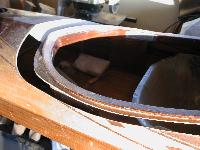Building the Forms
Hull Stripping
Deck Stripping
Fiberglassing
Coaming and Hatches
Finishing Steps
Launching
Fitting Out and Customizing
Materials Sources

| Shawn's Guillemot 18
Click on any picture in this page to see an enlarged view
Building the Forms Hull Stripping Deck Stripping Fiberglassing Coaming and Hatches Finishing Steps Launching Fitting Out and Customizing Materials Sources |
 |
Chapter 5: Coaming and Hatches
Chapter 8: Fitting Out and Customizing:
| My kayak has ultra-aggressive carved redwood knee
hooks. I also added some internal tiedown bungies to hold a bilge pump
and thermos or Nalgene bottle. These tiedowns won't work in boats
without hard chines, or with low decks, as there wouldn't be enough room
under your knees. These could present a potential foot entrapment
hazard, so evaluate your boat, your installation, and your own skills before
installing them on your own kayak AT YOUR OWN RISK!!
The front bulkhead is located at a distance from the seat that allows me to use it as a footbrace. It is also comfortably sloped forward to give me more foot room. |
|
| I fitted this kayak with a custom fiberglass seat and minicel hip pads covered with white neoprene. | |
 |
I chopped the deck of this kayak to put in a deeper coaming recess and lower the overall height of the coaming. |
| Except for the wood for the hull which I purchased at the
local lumberyard, I sourced the rest of my materials from companies who
advertised on the Internet. I must say that, without fail, the service,
prices, and quality products offered by the following companies was unmatched,
and I would recommend all of them again. By choosing multiple suppliers,
you can select good quality products at the lowest prices.
I did ask several of them to contact me via email before the order went out, to advise me of availability or the final price, and Edensaw, Certainly Wood, and John R. Sweet all failed to return my request, but the rest of their services and products were too good to complain about a single unsent message. This is the second time I have used Raka products. I whole- heartedly recommend their epoxies--a great value! Hamilton Marine and Klingspor were "first-time" suppliers, but they had great service and promptly and enthusiastically answered all of my questions.
|
| Supplier and materials ordered | Cost for portion of order used in boat |
| Hull wood purchased locally in Montana.
Cedar, redwood, pine |
$50 |
| Epoxy and accessories were from Raka
in Florida.
3 gallons, squeegees, fillers - nearly enough for 2 boats |
$100 |
| 5.5oz x 50" cloth from Hamilton
Marine in Maine
40 yards - enough for 2 boats |
$65 |
| 2" Fiberglass tape from John R.
Sweet, in Virginia
50-yard roll - enough for 2 boats |
$10 |
| Ash for inner and outer stems from Edensaw
in Washington.
8 BDFT - enough for plenty of projects |
$10 |
| Veneer for coaming from Certainly Wood in New York. |
$15 |
| ROS Discs from Klingspor in North Carolina |
$30 |
| I also bought a strobe and compass from Cyber-Marine.com, in Connecticut |
$45 |
| I will later have a friend do a 2-part sprayed Urethane finish on my boat. The urethane is $100 per gallon, but I will split that cost with my brother. |
$50 |
| Total Cost |
$370 |
|
I love ordering stuff off of the Internet! (My wife, on the other hand, is threatening to cut up my credit card!) |
|
| | Home | Sea Kayaking | Homebrewing | Inverted | Granite Peak | Log Furniture | |
Copyright © 2002 Shawn W. Baker